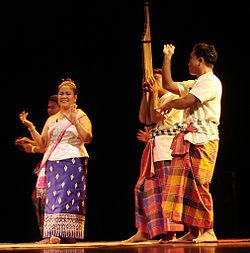Portal:Laos/Selected article/10

The dance and theatre of Laos (nattakam Lao, Lao: ນາດຕະກັມລາວ [nâːt táʔ kam láːw]) is the primary dramatic art form of Laos' majority ethnic group, the Lao people. It is shared with the ethnic Lao that inhabit the Isan region of Thailand as well. There are mainly two types of dances (or dance-dramas), the classical dances performed in the royal courts and the folk dances now associated with morlam.
Shadow puppetry, although not associated with dance, is an important part of Lao theatrical traditions. Various dance-drama troupes, mostly operating out of Louang Phrabang and Vientiane, continue to teach the old classical court dances and more Khmer-influenced dramas and folk dances, respectively.
The dance-dramas of Laos were originally only performed for the royal court. The dance-dramas and musical accompaniment are all very similar to those of Thai and Cambodian classical dances. Lao legends of the first ruler of Lan Xang say that in addition to a large army of Khmer soldiers, he was also accompanied by many female dancers from the court of Angkor.
Khon (ໂຂນ [kʰǒːn]) and Cambodian Royal ballet dance is the most stylised of the Lao dance-dramas, with troupes of male and female dancers in elaborate costumes and masks performing very graceful movements demonstrating their great flexibility, and very common dance-drama form for the Phra Lak Phra Ram.
Although lacking in dance, nang taloung or shadow puppets (ໜັງຕະລຸງ [nǎŋ táʔ lúŋ]) are an important part of Lao theatrical traditions. An adaptation of the traditional Malay wayang shadow puppets, but there are numerous puppeteers instead of one puppet master. Shadow puppet plays are based on similar themes and stories as the other classical dramas, but can be accompanied by either classical music or morlam instrumentation.
